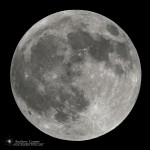This evening a thin crescent Moon will join Mercury in the sunset. The pair will be separated by just under 6°, at about the same elevation and 15° above the horizon at sunset. The Moon will be extremely thin, only 1.7% illuminated, while Mercury is shining at -1.2 magnitude.
Category: Sky Events
Sky events
New Moon
Neptune at Superior Conjunction
Today will see Neptune pass through superior conjunction with the Sun at 09:53HST. The planet will reappear in the dawn during the first weeks of March.
A Line of Bright Planets in the Evening
A nice lineup of three bright planets will be forming in the sunset over the next couple weeks. There will be three bright planets, Mercury, Venus and Jupiter, and a faint planet in the lineup, Uranus. Together they will nicely outline the ecliptic in the evening sky.
Tonight you can see this lineup taking shape, looking low, just above the glare of the setting Sun you might pick out Mercury. It is only 10° from the sun this evening, but getting higher each day. High above, Venus and Jupiter can not be missed, Venus at about 40° elevation at sunset, with Jupiter even higher at 60° elevation. Venus shines much brighter than Jupiter at about -4.2 magnitude while Jupter is only -2.3 magnitude. Uranus is hiding about halfway between Mercury and Venus at a mere 5.9 magnitude.
Over the next two weeks Mercury will climb higher, reaching maximum elongation on March 5th. At the same time Jupiter and Venus will draw closer, having a separation of about 9° on the 5th. The pair will be closest on March 13th, at about 3° separation. As March slips by, Mercury will drop back into the Sun’s glare and Jupiter and Venus will separate once again. Still, the bright pair dominating the evening sky through much of the month.
While the lineup is still prominent, the Moon will swing through the alignment from February 22nd to the 27th. On February 22nd a 1.8% illuminated Moon will pair up with Mercury, just 6° away. On the 24th and 25th the Moon will sidle up to Venus, under 5° away on the 25th. On the 26th the Moon will be near Jupiter, with under 4° away and 25% illuminated.
One last dance of the alignment will occur on March 25th when a crescent Moon will join Jupiter and Venus. The planets will be about 10° apart with a 11% illuminated Moon in between them. A very nice trio indeed.
Late February and much of March will be a nice show for sky watchers. Make a point to get out and look!
Mercury in the Sunset
Mercury is beginning an evening apparition this week. Look directly above the sunset for a starlike object shining at -1.2 magnitude. The planet will be over 10° from the Sun today, rising a little further each day until maximum elongation on March 5th.
The Moon and Saturn
Saturn will be about 7.5° from the Moon when they rise tonight. A 73% illuminated Moon will rise about 22:28, followed by Saturn at 22:58HST. The Moon will also be quite close to the bright star Spica, less than two degrees away from the 1st magnitude star.
Venus and Uranus
This evening Venus and Uranus are very close, with the pair separated by a mere 19 arc-minutes, about 1/5th of a degree and well within the same medium power telescopic field. This a is chance to find the ice-giant with relatively little effort, there will be no nearby bright stars to confuse with the 5.9 magnitude Uranus. At high magnification both planets will be seen as disks, Venus 16 arc-seconds across, and Uranus a bit over 3 arc-seconds across. Venus is now far enough between the Earth and the Sun to become somewhat gibbous, being about 70% illuminated.
The Moon and Mars
Tonight a nearly full Moon will rise together with the planet Mars. The pair will rise about 20:28 and will be about 9° apart.
Mars is approaching opposition, as the Earth draws closer to the red planet it is getting larger and brighter in our sky. It is now over 12 arc-seconds in diameter and shining at -0.8 magnitude. Opposition will occur March 3rd.
Full Moon
Venus and Uranus
Over the next few night Venus will pass very close to Uranus. The pair will be close for about five days, around 2° or less from the 7th to the 11th. It is on the 9th that the closest approach will occur with the pair separated by a mere 19 arc-minutes, about 1/5th of a degree and well within the same medium power telescopic field. This a is chance to find the ice-giant with relatively little effort, there will be no nearby bright stars to confuse with the 5.9 magnitude Uranus. At high magnification both planets will be seen as disks, Venus 16 arc-seconds across, and Uranus a bit over 3 arc-seconds across. Venus is now far enough between the Earth and the Sun to become somewhat gibbous, being about 70% illuminated.


